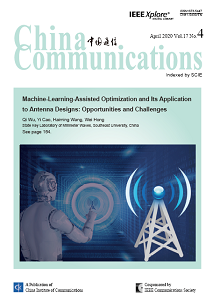Qi Wu, Yi Cao, Haiming Wang, Wei Hong
2020, 17(4): 152-164.
With the rapid development of modern wireless communications and radar, antennas and arrays are becoming more complex, therein having, e.g., more degrees of design freedom, integration and fabrication constraints and design objectives. While full-wave electromagnetic simulation can be very accurate and therefore essential to the design process, it is also very time consuming, which leads to many challenges for antenna design, optimization and sensitivity analysis (SA). Recently, machine-learning-assisted optimization (MLAO) has been widely introduced to accelerate the design process of antennas and arrays. Machine learning (ML) methods, including Gaussian process regression, support vector machine (SVM) and artificial neural networks (ANNs), have been applied to build surrogate models of antennas to achieve fast response prediction. With the help of these ML methods, various MLAO algorithms have been proposed for different applications. A comprehensive survey of recent advances in ML methods for antenna modeling is first presented. Then, algorithms for ML-assisted antenna design, including optimization and SA, are reviewed. Finally, some challenges facing future MLAO for antenna design are discussed.
